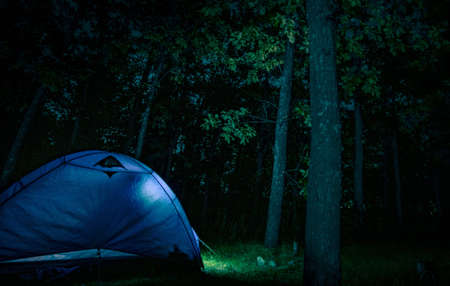1. Choose the Right Bags and Containers
Packing your camping gear for a smooth setup in the dark starts with picking the right bags and containers. In the U.S., campers often use duffel bags, plastic bins, or backpacks that are sturdy, easy to carry, and simple to organize. Think about what you’ll need to grab first when you get to camp after sunset—like your tent, flashlight, or matches—and pack those items where they’re easiest to reach.
Benefits of Different Bag Types
| Bag Type | Best For | Why It’s Useful at Night |
|---|---|---|
| Duffel Bag | Bedding, clothes, bulky gear | Wide opening makes it easy to find things by feel or with a headlamp |
| Plastic Bin (Tote) | Kitchen supplies, food, small gear | Keeps items dry and organized; stackable for quick access |
| Backpack | Personal essentials, hiking gear | Multiple pockets help keep essentials handy; can be worn while setting up camp |
Pro Tips for Organizing Your Bags
- External Pockets: Use outside pockets for flashlights, headlamps, or pocket knives. This way you don’t have to dig around in the dark.
- Clear Labels: Label each bag or bin with bold, large print or tactile stickers so you can identify them quickly—even if you’re using just your sense of touch.
- Color Coding: Assign different colors to bags based on their contents—like blue for cooking supplies or red for first aid—so you can spot what you need fast with a flashlight.
- Packing Order: Pack the items you’ll need first on top or in the most accessible compartments.
Example Packing System:
| Bag/Container Color | Main Contents | Pocket Items | Label Example |
|---|---|---|---|
| Navy Duffel Bag | Tent, sleeping bag, pillow | Headlamp, gloves | “Sleep Kit” |
| Clear Plastic Tote | Pots, pans, utensils, snacks | Lighter, dish soap packets | “Camp Kitchen” |
| Green Backpack | Sunscreen, bug spray, maps, first aid kit | Pocket knife, whistle, compass | “Day Pack” |
Selecting the right bags and containers—and organizing them well—makes it much easier to set up camp after dark without stress. Keep these tips in mind as you gather your gear for your next adventure.
2. Sort Gear by Setup Priority
When you arrive at your campsite after dark, nothing is worse than digging around in the trunk for a flashlight or tent poles. The trick is to group your gear by what youll need first, and pack those items last so they’re right on top and easy to grab—even if you can barely see.
Why Setup Priority Matters
In the dark, you want to move quickly and safely. By sorting your gear ahead of time, you’ll avoid unnecessary stress and save time. Think about what you always reach for immediately: headlamps, lanterns, tent, stakes, rainfly, and sleeping gear. If these are easily accessible, setting up camp becomes a breeze.
How to Group Your Camping Gear
| Setup Priority | Examples of Gear | Packing Tip |
|---|---|---|
| First Out | Headlamp, lantern, tent bag, stakes, ground tarp | Pack these last so they’re on top and easy to find |
| Second Out | Sleeping pad, sleeping bag, pillow | Keep together in one duffel or compression sack just below the tent gear |
| Third Out | Camp chairs, table, kitchen bin, cooler | Arrange near the back of your vehicle for quick unloading after camp setup |
| Last Out | Clothes bag, extra gear, non-essentials | Stash at the bottom or further inside your car—they can wait until morning! |
Packing Pro Tips for Dark Arrivals
- Color code or label bags: Use colored stuff sacks or duct tape labels so you know what’s what without searching.
- Keep lighting separate but handy: A headlamp or flashlight should go in your glove box or door pocket—not deep in your backpack.
- Pretend it’s a relay race: Practice packing and unpacking at home to make sure you know where everything is when it really counts.
- If you’re camping with kids: Give everyone their own small bag with nighttime essentials like a flashlight and a warm layer.
The key is to think ahead and pack smart—your future self will thank you when you’re setting up camp smoothly under the stars!

3. Prep Lighting Essentials
When you’re getting your camping gear ready for an after-dark setup, having your lights easy to grab is a total game-changer. Nobody wants to fumble around in the dark looking for a flashlight or headlamp. Here’s how to pack your lighting essentials so you can light up camp fast and stress-free.
Keep Your Lights in a Go-To Spot
Always pack your headlamps, lanterns, and spare batteries in the same place every trip. Consistency makes all the difference when it’s pitch black and you need light ASAP. The best spots are super accessible—think the top pocket of your backpack, a hip belt pocket, or your car’s glove box if you’re car camping.
Lighting Gear Packing Cheat Sheet
| Item | Recommended Storage Spot |
|---|---|
| Headlamp | Top pocket of backpack or jacket pocket |
| Lantern | Easily reachable gear bin or car door compartment |
| Spare Batteries/Power Bank | Small dry bag inside main pack or glove box |
| Flashlight (optional) | Side pocket of daypack or center console in vehicle |
Pro Tips for Night-Ready Lighting
- Test before you go: Make sure all your lights work and have fresh batteries.
- Glow-in-the-dark tape: Add some to your headlamp or lantern handles so they’re easy to spot after sunset.
- Pocket check: Right before leaving home, double-check that your lighting gear is exactly where you want it for fast access.
- Backup plan: Always bring more batteries than you think you’ll need—it’s a classic rookie mistake to run out!
4. Bundle and Pre-assemble Critical Items
When youre setting up camp in the dark, nothing slows you down more than digging through your gear for small but essential items. To make things easier, its smart to bundle and pre-assemble your most critical camping equipment before you even leave home. This way, you can get your shelter up quickly and start relaxing under the stars.
Pre-pack Tent Gear Together
A great trick is to pack your tent poles, stakes, and rainfly all together in one bag or stuff sack. This means when it’s time to set up camp—especially after sunset—you won’t have to search for each piece separately. Keeping these items together also helps prevent losing anything important along the trail or at your campsite.
| Tent Gear | Packing Tip |
|---|---|
| Pole Set | Roll inside the tent body or keep in a dedicated pouch |
| Stakes | Store in a zippered pouch attached to the pole bag |
| Rainfly | Fold and wrap around tent poles for easy access |
Organize Kitchen Gear in Clear Bins
For your kitchen setup, use clear plastic bins so you can see what’s inside without opening everything up. Label each bin by function—for example, “Cooking,” “Utensils,” or “Cleaning.” This method keeps things neat and makes grabbing what you need super simple, even with just a headlamp for light.
Sample Kitchen Bin Organization
| Bin Label | Contents Example |
|---|---|
| Cooking | Stove, fuel, lighter, pots/pans |
| Utensils | Spoons, forks, knives, spatula |
| Cleaning | Sponge, biodegradable soap, towel, trash bags |
Pre-assemble Simple Items at Home
If you have any gear that can be partially assembled ahead of time—like putting batteries in lanterns or attaching guy lines to tarps—do it before you leave. This little bit of prep work saves time and reduces stress when setting up at night. Plus, youll avoid common mistakes like forgetting parts or assembling things incorrectly in low light.
5. Keep a Checklist and Practice Packing
Staying organized is key when you want to set up your campsite quickly, especially in the dark. Using a checklist ensures you never leave behind essential gear like your headlamp, tent stakes, or sleeping bag. Before every trip, go through your list and physically check off each item as you pack it.
Sample Camping Gear Checklist
| Category | Essential Items |
|---|---|
| Shelter | Tent, stakes, rainfly, ground tarp |
| Sleeping | Sleeping bag, sleeping pad, pillow |
| Lighting | Headlamp, flashlight, extra batteries |
| Cooking | Stove, fuel, lighter, utensils, cookware |
| Clothing | Layers, socks, beanie, rain jacket |
| Safety/First Aid | First aid kit, insect repellent, sunscreen |
| Other Essentials | Water bottle, snacks, map/compass, multi-tool |
Practice Makes Perfect: Dry Runs at Home
Packing isn’t just about remembering everything—it’s also about knowing where it all goes. Do a couple of dry runs at home by loading and unloading your gear into your car or backpack. Time yourself so you get faster each time. This practice helps build muscle memory so that when you arrive at your campsite after dark, you can find what you need without fumbling around.
Packing Tips for Fast Setup in the Dark:
- Always pack lighting (headlamp or lantern) last so its easy to grab first.
- Store similar items together—like cooking gear in one tote and sleeping gear in another.
- Label bins or bags with duct tape and a marker for quick identification.
- Keep your checklist handy on your phone or printed out in your glove box.
- If possible, assign each person their own bin or bag to avoid confusion.
Remember:
The more you practice packing and unpacking at home, the more confident and efficient you’ll be at camp—even if youre setting up under the stars with only a flashlight to guide you.


